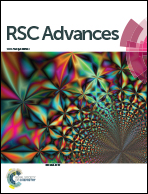A highly active Ca/Cu/YCeO2–TiO2 catalyst for the transient reduction of NO with CO and naphthalene under oxidizing conditions†
Abstract
The transient combustion of biomass leads to the evolution of a variety of pollutants (NO, CO, organic compounds, and many others) that can react with each other on a suitable catalyst to generate compounds of lower toxicity. Here, the transient reduction of NO with CO and naphthalene in the presence of oxygen was studied on a Ca/Cu/YCeO2–TiO2 catalyst. Response surface methodology was used to identify the optimum amounts of calcium, copper, and cerium. The optimized Ca/Cu/YCeO2–TiO2 catalyst was then extensively studied and characterized. The coupling of yttrium-stabilized ceria with TiO2 provided an active support that effectively activated naphthalene. When calcium and copper were added to the support, the obtained Ca/Cu/YCeO2–TiO2 catalyst achieved the full conversion of CO and naphthalene and 72% conversion of NO. The Ca/Cu/YCeO2–TiO2 catalyst possessed labile oxygen species, which might be related to the high catalytic activity.



 Please wait while we load your content...
Please wait while we load your content...